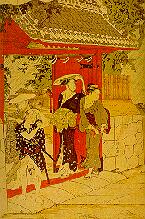 |
During the An'ei and Tenmei eras (1772-1789), the Kitao School came into being under the leadership of Shigemasa (1739-1820), and he is believed to have trained many pupils, including Utamaro, Hokusai, and Santo Kyoden, one of the giants of Edo era literature.
 |
During the Tenmei (1781-1789) and Kansei (1789-1804) eras, many ukiyoe artists appeared and ukiyoe publishers vied with each other in selling their wares. Among the famous ukiyoe artists of this period are Torii Kiyonaga, Shigemasa, Kitagawa Shun-ei, Kitagawa Utamaro, Chobunsai Eishi, Toshusai Sharaku, Utagawa Toyoharu (1735-1814), and Utagawa Toyokuni (1769-1825).
Kiyonaga produced his famous "kiyonaga women". He made many diptychs- and triptychs-ukiyoe in order to represent his refined figural groups, and his works were quite successful. Utamaro, who has probably been the most famous ukiyoe artists, was also good at depicting beautiful women, and especially his okubie, or "neck" prints are well-known. Sharaku, whose life is still uncertain, is also known throughout the world for his subjects' exaggerated and unique style. Toyoharu is probably most remembered for his landscape prints, and later, his works influenced Hokusai and Hiroshige. Toyoharu's pupil, Toyokuni, produced many ukiyoe of actors and beautiful women and made the Utagawa school bigger and more successful.
All of these great artists brought the Floating World to its zenith with many supports by townspeople in Edo.
| Next Stage: Age of Decadence |
| Previous Stage |